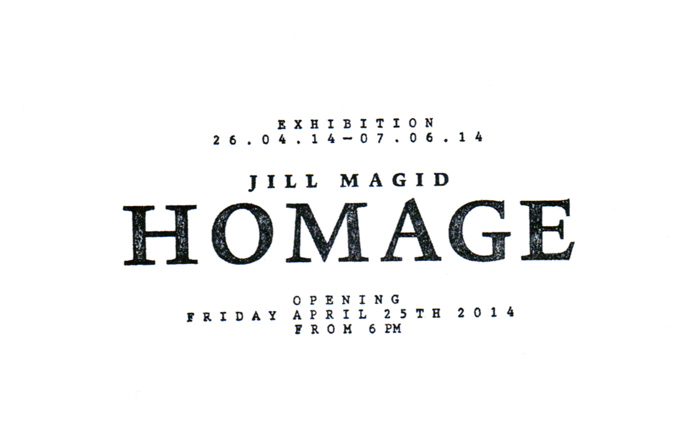PRESS RELEASE
Jill Magid. Homage
26.04.2014 – 07.06.2014
Pfingstweidstrasse 23 / Welti-Furrer Areal, 8005 Zürich
Opening reception: Friday, 25.04.2014, 6-9 pm
RaebervonStenglin is proud to present Jill Magid's first solo exhibition with the gallery. Magid's art explores systems — in the past working with police, CCTV and forensics for instance — intimately implicating itself in their logic and processes. Concerned with the relationships between the personal, the social and artistic practice, her work is chameleon-like in its ability to assume different forms: 'If my subject is made of clay, I will work in clay', she has stated; and conceptual in the grasp of its formalism: 'Permission is a material that changes the work's consistency.'
In 'Homage' Magid considers the eschewal of intellectual property rights in favour of sharing. This concept is explored through the mutually respectful relationship between the Bauhaus modernist Josef Albers and Mexico's pre-eminent modernist architect Luis Barragán who were both especially renowned for their use of colour. The title of the exhibition borrows from Albers' famous painting series, Homage to a Square, whilst considering Barragán's particular homage to Albers — his ownership of two unlicensed reproductions of Albers' works. Allegedly bought for just a dollar each from a strip mall in the United States, these cheap reproductions printed on fabric differ substantially from the original oil paintings which they purport to be. Yet it is a commonly held myth that Barragán displayed two original Josef Albers' paintings in his house and photographs depicting one of these reproductions hung above the table in the architect's living room have become iconic. Such was Albers' admiration for Barragán that rather than disapproving he was said to be pleased.
Aided by the precise notes Albers left on the back of his paintings which tell of the colours, brands and condition of each of the paints he used, but thwarted by many of the pigments no longer being in existence, Magid makes her own 'Homages', forging Albers' works according to his own instructions. In so doing, she questions the notions of authorship and originality, whilst entering into the relationship between artist and architect. These 'Homages' will be shown in the company of 'Butaca' chairs which Magid has made through a process of further replication, involving another figure in the exchange of ideas. Butaca are low-sitting sling chairs have existed in Mexico for centuries with different versions existing in different towns. In the '40s, Cuban-born, Mexican-based designer Clara Porset studied these chairs and reintroduced them with ergonomic changes. Porset worked with Barragán who is also attributed a version of the chair, and was friends with Albers, allowing the latter to trace the dimensions of her chair and reproduce it for every dorm room in Black Mountain College — a version that is attributed to Albers. Furthering the logic of this appropriation, Magid presents her own Butaca chair, made by tracing the contours Albers' own traced version. Such a tracing can only be inexact, Magid explains, 'always an attempt at reproduction', homages rather than forgeries.
With gratitude to the Josef and Anni Albers Foundation for its support.
With gratitude to the Josef and Anni Albers Foundation for its support.
Jill Magid was born in Bridgeport, Connecticut, in 1973. She received a Master of Science in Visual Science at the Massachusetts Institute of Technology, Cambridge, and her Bachelor of Fine Arts from Cornell University in Ithaca, New York. Magid was an artist-in-residence at the Rijksakademie van Beeldende Kunsten in the Netherlands from 2000-2. She has received various rewards, including the Basis Stipendium from Fonds Voor Beeldende Kunsten in the Netherlands in 2006 and a Netherland-American Foundation Fellowship Fulbright Grant from 2001-2002. Recent solo exhibitions include 'Woman with Sombrero', New Commissions, Art in General (2013), travelling to Yvon lambert Paris; and 'Faust 24', Labor, Mexico City (2012). Her work has been the subject of solo exhibitions at numerous institutions including: 'Closet Drama', Berkeley Museum of Art, California (2011); 'A Reasonable Man in a Box', Whitney Museum of American Art, New York (2010); 'Authority to Remove', Tate Modern, London (2009); 'Article 12', Stroom, The Hague, Netherlands (2008); 'Evidence Locker', Sparwasser, Berlin (2007); 'Thin Blue Lines', The Centre D’Arte Santa Monica, Barcelona (2007); and 'Libration Point', Stedelijk Museum Bureau Amsterdam (2005). She lives and works in New York where she is adjunct professor at Cooper Union and currently a fellow at the Vera List Center for Arts and Politics at The New School.







































































